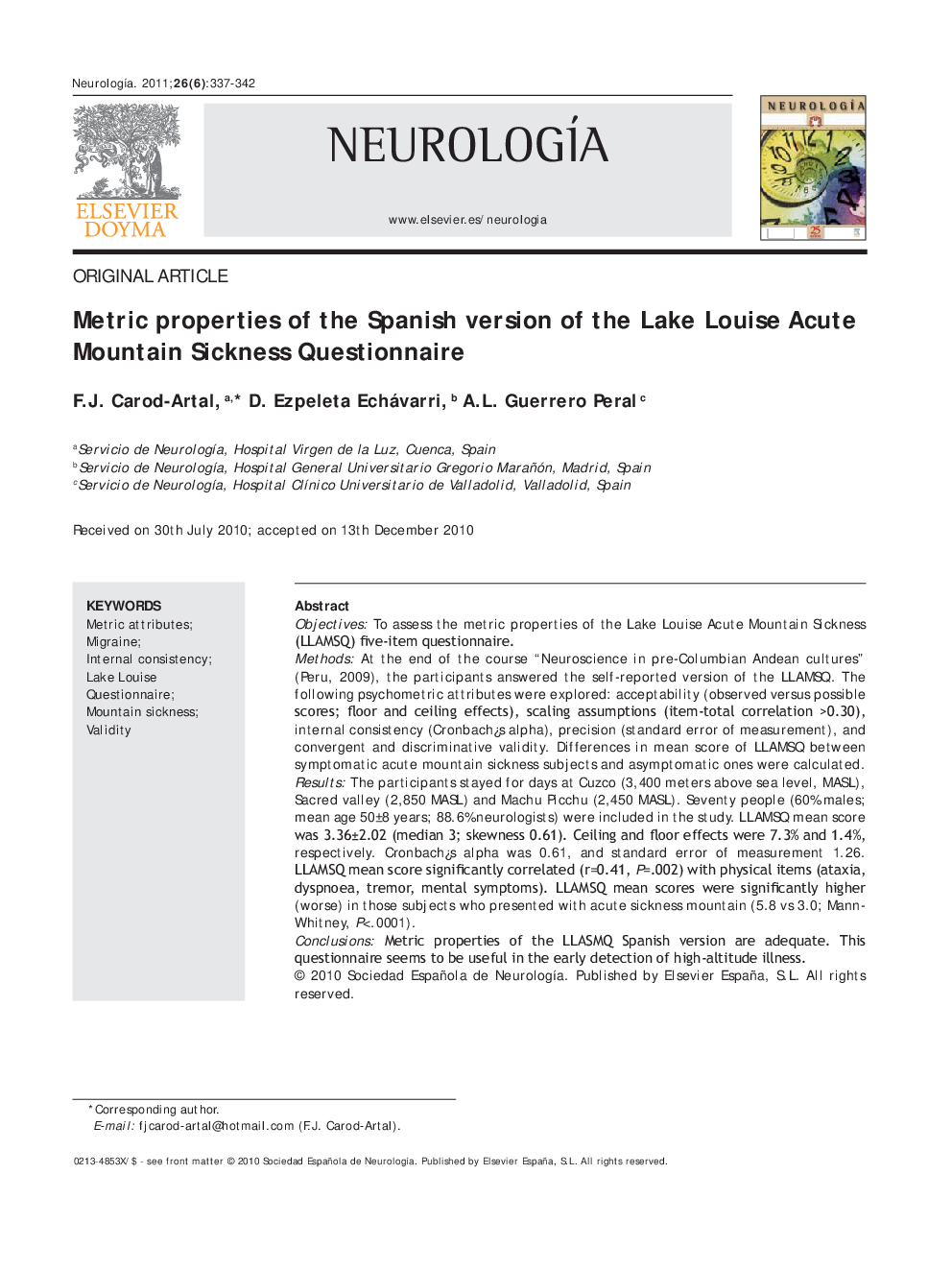| کد مقاله | کد نشریه | سال انتشار | مقاله انگلیسی | نسخه تمام متن |
|---|---|---|---|---|
| 3077492 | 1189148 | 2011 | 6 صفحه PDF | دانلود رایگان |

ObjectivesTo assess the metric properties of the Lake Louise Acute Mountain Sickness (LLAMSQ) five-item questionnaire.MethodsAt the end of the course “Neuroscience in pre-Columbian Andean cultures” (Peru, 2009), the participants answered the self-reported version of the LLAMSQ. The following psychometric attributes were explored: acceptability (observed versus possible scores; floor and ceiling effects), scaling assumptions (item-total correlation >0.30), internal consistency (Cronbach¿s alpha), precision (standard error of measurement), and convergent and discriminative validity. Differences in mean score of LLAMSQ between symptomatic acute mountain sickness subjects and asymptomatic ones were calculated.ResultsThe participants stayed for days at Cuzco (3,400 meters above sea level, MASL), Sacred valley (2,850 MASL) and Machu Picchu (2,450 MASL). Seventy people (60% males; mean age 50±8 years; 88.6% neurologists) were included in the study. LLAMSQ mean score was 3.36±2.02 (median 3; skewness 0.61). Ceiling and floor effects were 7.3% and 1.4%, respectively. Cronbach¿s alpha was 0.61, and standard error of measurement 1.26. LLAMSQ mean score significantly correlated (r=0.41, P=.002) with physical items (ataxia, dyspnoea, tremor, mental symptoms). LLAMSQ mean scores were significantly higher (worse) in those subjects who presented with acute sickness mountain (5.8 vs 3.0; Mann-Whitney, P<.0001).ConclusionsMetric properties of the LLASMQ Spanish version are adequate. This questionnaire seems to be useful in the early detection of high-altitude illness.
ResumenObjetivosEvaluar las propiedades métricas de la versión española del Cuestionario de Mal de Altura del Lago Louise (CMALL) autoaplicado de 5 ítems.MétodosTras el curso-seminario «Neurociencia en las culturas andinas precolombinas» (Perú, 2009), se entregó una encuesta a los participantes que incluía el CMALL. Se evaluó la aceptabilidad de los ítems (puntuaciones observadas vs valores posibles, efectos techo y suelo), asunciones escalares (correlación ítem-total > 0,30), consistencia interna (alfa de Cronbach), precisión (error estándar de la medida) y validez de convergencia y discriminante. Esta última se evaluó calculando el valor medio del CMALL entre aquellos neurólogos que creían haber presentado mal de altura frente a quienes no lo habían presentado.ResultadosEstancia por días en altura: Cuzco 3.400 m sobre el nivel del mar (msnm), Valle Sagrado (2.850 msnm) y Machu Picchu (2.450 msnm). Se incluyeron 70 sujetos (60% varones, edad media 50 ± 8 años, 88,6% neurólogos). El valor medio del CMALL fue 3,36 ± 2,02 (mediana 3, asimetría 0,61). Los efectos techo y suelo fueron 7,3 y 1,4%. El alfa de Cronbach fue 0,61 y el error estándar de la medida 1,26. El CMALL se correlacionó significativamente (r = 0,41, p = 0,002) con los ítems de exploración física (ataxia, disnea, temblor, síntomas mentales). Las puntuaciones del CMALL fueron significativamente mayores (peores) en quienes presentaron mal de altura (5,8 vs 3,0; Mann-Whitney, p < 0,0001).ConclusionesLas propiedades métricas de la versión española del CMALL parecen ser adecuadas. Este cuestionario puede ser útil en la detección precoz del mal de altura.
Journal: Neurología (English Edition) - Volume 26, Issue 6, 2011, Pages 337–342